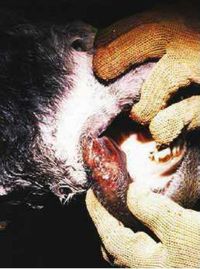Difference between revisions of "Glanders (Farcy) - Donkey"
m (→Diagnosis) |
|||
| (One intermediate revision by one other user not shown) | |||
| Line 21: | Line 21: | ||
''(Note: The enlarged submandibular lymph nodes of infected donkeys may resemble those seen with [[Strangles|strangles]]. Skin forms may resemble [[Epizootic Lymphangitis/Histoplasmosis - Donkey|epizootic lymphangitis]] or ulcerative lymphangitis)'' | ''(Note: The enlarged submandibular lymph nodes of infected donkeys may resemble those seen with [[Strangles|strangles]]. Skin forms may resemble [[Epizootic Lymphangitis/Histoplasmosis - Donkey|epizootic lymphangitis]] or ulcerative lymphangitis)'' | ||
* '''Mallein test''' | * '''Mallein test''' | ||
| − | * Demonstration of the | + | * Demonstration of the causal pathogens in '''smears of lesions''' stained with methylene blue or Gram stain |
==Treatment and control== | ==Treatment and control== | ||
[[Euthanasia - Donkey|Euthanasia]] is usually recommended due to the contagious nature of the condition, the '''zoonotic''' potential and the specific disease control legislation and strategies in place in many countries. Strict biosecurity when handling infected animals is mandatory. Vaccines are not currently available for this condition. | [[Euthanasia - Donkey|Euthanasia]] is usually recommended due to the contagious nature of the condition, the '''zoonotic''' potential and the specific disease control legislation and strategies in place in many countries. Strict biosecurity when handling infected animals is mandatory. Vaccines are not currently available for this condition. | ||
| + | |||
| + | ==Literature Search== | ||
| + | [[File:CABI logo.jpg|left|90px]] | ||
| + | |||
| + | |||
| + | Use these links to find recent scientific publications via CAB Abstracts (log in required unless accessing from a subscribing organisation). | ||
| + | <br><br><br> | ||
| + | [http://www.cabdirect.org/search.html?q=%28title%3A%28glanders%29+OR+title%3A%28farcy%29+OR+title%3A%28%22Burkholderia+mallei%22%29+OR+title%3A%28Pseudomonas+mallei%29%29+AND+%28od%3A%28donkeys%29+OR+title%3A%28donkey%29+OR+ab%3A%28donkey%29%29 Glanders in donkeys publications] | ||
==References== | ==References== | ||
Latest revision as of 10:33, 21 May 2014
Introduction
Glanders is a contagious and often fatal disease of horses, donkeys and mules caused by the bacterium Burkholderia mallei. The infection is transmitted via ingestion of the bacteria or contamination of skin abrasions. The bacteria can survive in the environment for up to two months. Humans can acquire the infection, which is usually fatal. Glanders occurs in Asia, Africa and the Middle East. It was last reported in the UK in 1928.
Clinical features
The disease tends to be more acute and of higher mortality in donkeys and mules compared to the chronic course of skin ulcers and nodules typically seen in horses. Three forms of the disease are generally recognised (Radostits, 2000):
- Pulmonary form: cough, chronic pneumonia, frequent epistaxis and laboured respiration.
- Nasal form: ulcerating nodules in turbinates, serous to purulent nasal discharge, enlarged submandibular lymph nodes.
- Skin form: subcutaneous discharging nodules, particularly on the legs. Fibrous lymph vessels may connect nodules, and regional lymph nodes may enlarge and discharge (referred to as ‘farcy’).
In donkeys and mules the main presenting signs can be (Vetstream, 2004):
- Acute, systemic illness with pyrexia, cough and nasal discharge. This is often fatal
- Chronic respiratory form with general malaise, coughing, unthriftiness, intermittent pyrexia, nodular lymph node enlargement, frequent bouts of epistaxis and laboured respiration
Diagnosis
- Clinical signs:
(Note: The enlarged submandibular lymph nodes of infected donkeys may resemble those seen with strangles. Skin forms may resemble epizootic lymphangitis or ulcerative lymphangitis)
- Mallein test
- Demonstration of the causal pathogens in smears of lesions stained with methylene blue or Gram stain
Treatment and control
Euthanasia is usually recommended due to the contagious nature of the condition, the zoonotic potential and the specific disease control legislation and strategies in place in many countries. Strict biosecurity when handling infected animals is mandatory. Vaccines are not currently available for this condition.
Literature Search
Use these links to find recent scientific publications via CAB Abstracts (log in required unless accessing from a subscribing organisation).
Glanders in donkeys publications
References
- Anzuino, J. (2008) Exotic infections In Svendsen, E.D., Duncan, J. and Hadrill, D. (2008) The Professional Handbook of the Donkey, 4th edition, Whittet Books, Chapter 14
- Radostits O.M., Gay, C.C., Blood, D.C., and Hinchliff, K.W. (eds). (2000). Veterinary Medicine. A textbook of the diseases of cattle, sheep, pigs, goats and horses. Saunders Company Ltd, London.
- Vetstream (2004). Equis-CD Rom. Jan-Mar Q1/2004 Edition. Vetstream Ltd. Three Hills Farm, Bartlow, Cambridge CB1 6EN, UK.
|
|
This section was sponsored and content provided by THE DONKEY SANCTUARY |
|---|

